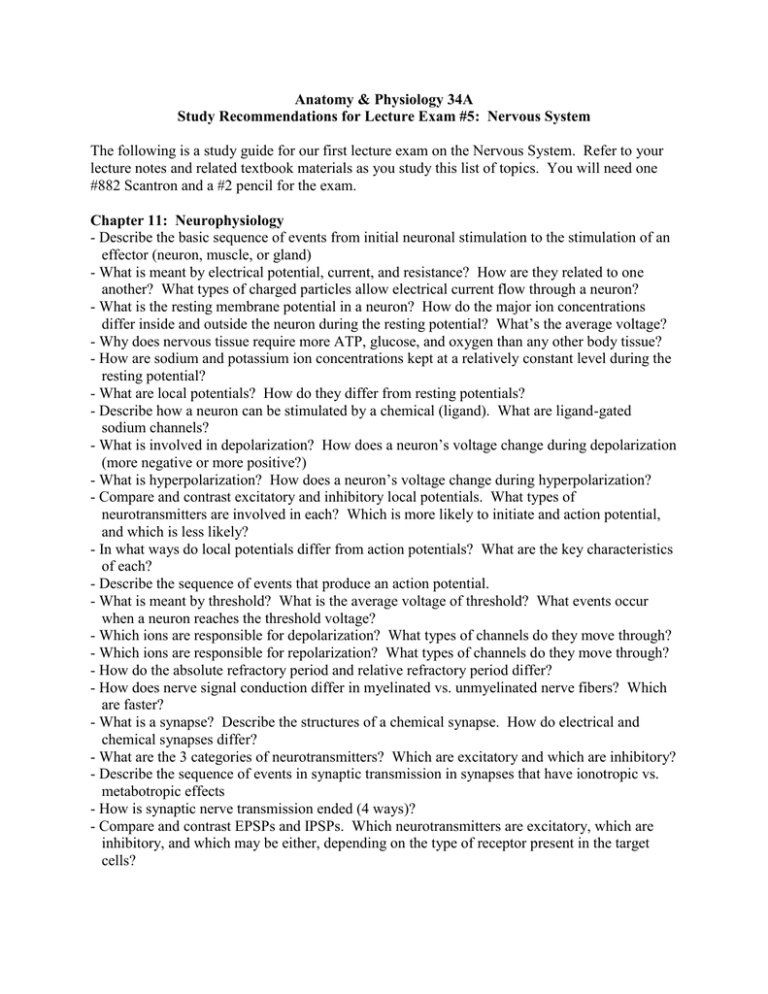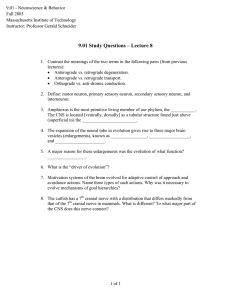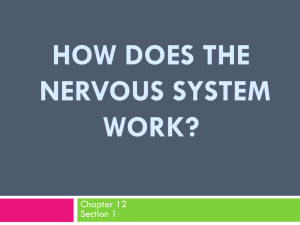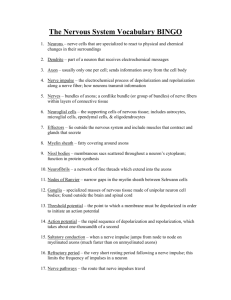Lecture Exam 5 Study Guide
advertisement

Anatomy & Physiology 34A Study Recommendations for Lecture Exam #5: Nervous System The following is a study guide for our first lecture exam on the Nervous System. Refer to your lecture notes and related textbook materials as you study this list of topics. You will need one #882 Scantron and a #2 pencil for the exam. Chapter 11: Neurophysiology - Describe the basic sequence of events from initial neuronal stimulation to the stimulation of an effector (neuron, muscle, or gland) - What is meant by electrical potential, current, and resistance? How are they related to one another? What types of charged particles allow electrical current flow through a neuron? - What is the resting membrane potential in a neuron? How do the major ion concentrations differ inside and outside the neuron during the resting potential? What’s the average voltage? - Why does nervous tissue require more ATP, glucose, and oxygen than any other body tissue? - How are sodium and potassium ion concentrations kept at a relatively constant level during the resting potential? - What are local potentials? How do they differ from resting potentials? - Describe how a neuron can be stimulated by a chemical (ligand). What are ligand-gated sodium channels? - What is involved in depolarization? How does a neuron’s voltage change during depolarization (more negative or more positive?) - What is hyperpolarization? How does a neuron’s voltage change during hyperpolarization? - Compare and contrast excitatory and inhibitory local potentials. What types of neurotransmitters are involved in each? Which is more likely to initiate and action potential, and which is less likely? - In what ways do local potentials differ from action potentials? What are the key characteristics of each? - Describe the sequence of events that produce an action potential. - What is meant by threshold? What is the average voltage of threshold? What events occur when a neuron reaches the threshold voltage? - Which ions are responsible for depolarization? What types of channels do they move through? - Which ions are responsible for repolarization? What types of channels do they move through? - How do the absolute refractory period and relative refractory period differ? - How does nerve signal conduction differ in myelinated vs. unmyelinated nerve fibers? Which are faster? - What is a synapse? Describe the structures of a chemical synapse. How do electrical and chemical synapses differ? - What are the 3 categories of neurotransmitters? Which are excitatory and which are inhibitory? - Describe the sequence of events in synaptic transmission in synapses that have ionotropic vs. metabotropic effects - How is synaptic nerve transmission ended (4 ways)? - Compare and contrast EPSPs and IPSPs. Which neurotransmitters are excitatory, which are inhibitory, and which may be either, depending on the type of receptor present in the target cells? 2 - What is meant by summation, facilitation, and inhibition? How does each affect nerve transmission? - How is neural coding achieved in the nervous system (qualitative vs. quantitative information)? - Describe the 4 types of neuronal circuits. Chapter 12: Spinal Cord - Know the structures or the spinal cord, as well as the meningeal layers surrounding it. - What is meningitis? - What is the main function of the white matter in the SC? Of the gray matter? - Where does the spinal cord end? - What are the two enlarged areas of the SC? Why are they enlarged? - What types of neurons enter the SC posterior gray horns? What types of neurons are found in the anterior gray horns? In the lateral gray horns? - Describe the 3 major ascending tracts in the SC, what types of impulses they conduct, and to what region of the brain they relay the impulses - Describe the 3 main descending tracts in the SC, what types of impulses they conduct, and from what brain regions they relay the impulses - What is a lumbar puncture? Where is it performed? Why is it performed? - What is spina bifida? How can it be prevented? - Differentiate between paraplegia and quadraplegia. Chapter 12 & 13: Spinal Nerves & Reflexes - List the 31 spinal nerves. - What is found in the dorsal root ganglion? What exits the ventral root? - What general body areas are served by the dorsal and ventral rami? Which ramus forms the 4 major nerve plexuses? - Describe the 4 major nerve plexuses, their components mentioned in class, and what structures they innervate. - What is sciatica? What are some of its causes? - Differentiate between somatic reflexes and visceral reflexes. What are the effectors in each? - What are the 7 components of a reflex arc? - How do ipsilateral reflex arcs differ from contralateral reflex arcs? - Know the somatic reflexes mentioned in class. Which are monosynaptic? Myotactic? Ipsilateral? Contralateral? What is meant by reciprocal inhibition? - Know the visceral reflexes mentioned in class Chapter 12: Brain & Cranial Nerves - Know what brain structures are formed by the prosencephalon, mesencephalon, and rhombencephalon in the embryo - What are the 4 major regions of the brain? What structures are found in each region? - What are the 3 meningeal tissues around the brain? Name the spaces associated with the tissues - What is the blood-brain barrier? What types of substances does it exclude from the brain? What types of substances does it allow entry into the brain? - Describe the composition of CSF. How is CSF produced? How much is produced per day? How much is usually present in the CNS? Where is it found? What is its purpose? Describe how it circulates in and around the brain & spinal cord. What happens if the flow is blocked? - What are the major functions of the cerebrum? Describe where the gray and white matter are located in the cerebrum 3 - Name the 5 paired lobes of the cerebrum and the main functional areas found in each lobe. - Name the major gyri, sulci, and fissures of the brain, as well as their functions. - Differentiate between commissures, association tracts, and projection tracts in the brain & SC - What is the choroid plexus, and where is it found in the brain? - What brain components are part of the basal nuclei? What is its function? What disorders occur when the basal nuclei are damaged? - Name the components of the diencephalon, as well as their main functions. - Name the components of the brainstem, as well as their main functions. Where do ascending and descending nerve tracts decussate? - Describe the cerebellum and its main functions. - Where is the reticular activating system found, and what are its main functions? - What are the components of the limbic system and their main functions? - Name the types of brain waves seen on EEGs in waking and sleeping states - What results when different cerebral lobes are damaged? - Know the CNS disorders mentioned in class - Know the names and numbers of the 12 cranial nerves, where they emerge from the brain, whether they are sensory, mostly motor, or mixed, their functions, how they are tested, and what happens if they are damaged.






